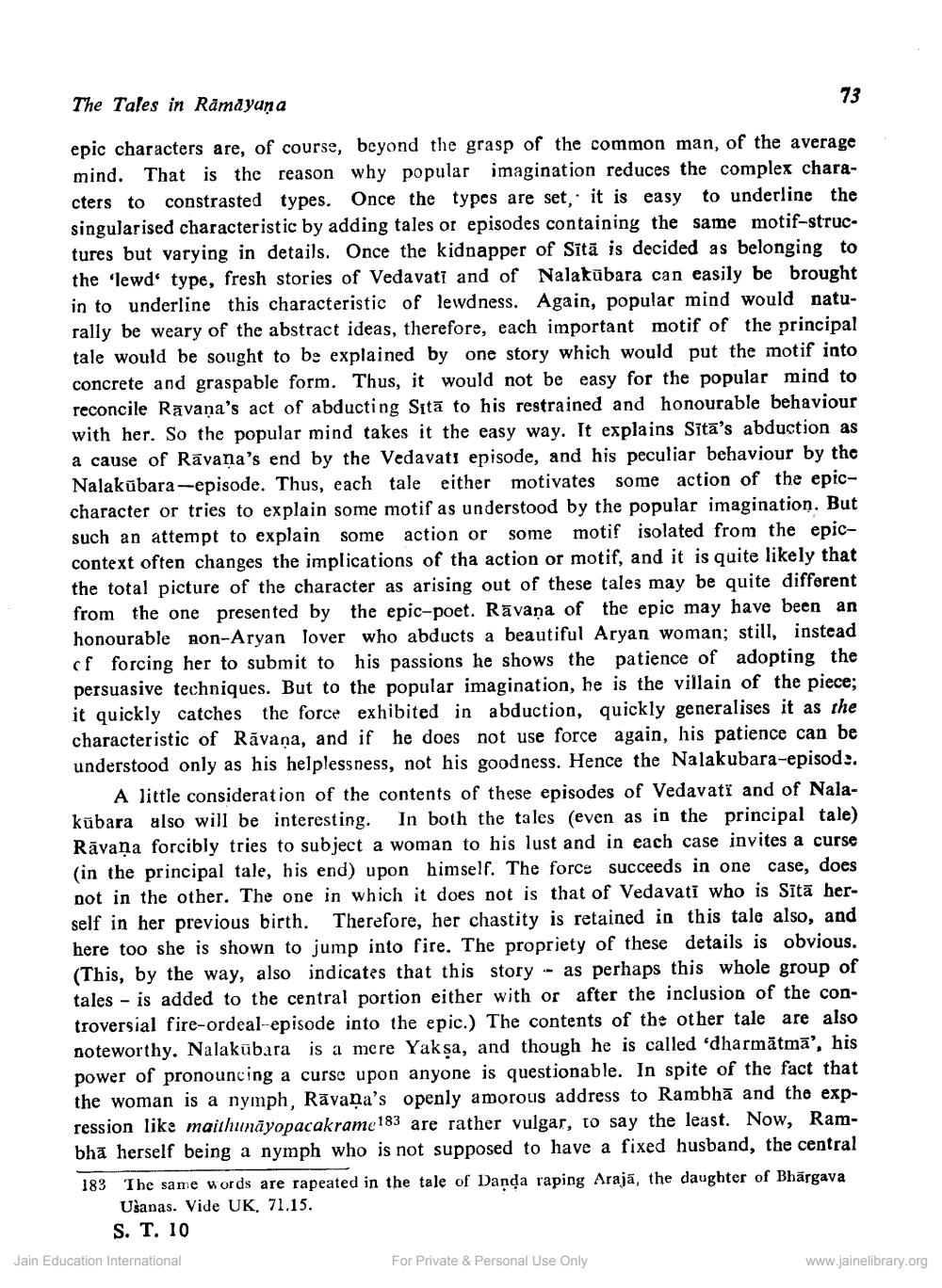________________
73
The Tales in Ramayana
epic characters are, of course, beyond the grasp of the common man, of the average mind. That is the reason why popular imagination reduces the complex characters to constrasted types. Once the types are set, it is easy to underline the singularised characteristic by adding tales or episodes containing the same motif-structures but varying in details. Once the kidnapper of Sita is decided as belonging to the lewd type, fresh stories of Vedavati and of Nalakübara can easily be brought in to underline this characteristic of lewdness. Again, popular mind would naturally be weary of the abstract ideas, therefore, each important motif of the principal tale would be sought to be explained by one story which would put the motif into concrete and graspable form. Thus, it would not be easy for the popular mind to reconcile Ravana's act of abducting Sita to his restrained and honourable behaviour with her. So the popular mind takes it the easy way. It explains Sita's abduction as a cause of Ravana's end by the Vedavatt episode, and his peculiar behaviour by the Nalakübara-episode. Thus, each tale either motivates some action of the epiccharacter or tries to explain some motif as understood by the popular imagination. But such an attempt to explain some action or some motif isolated from the epiccontext often changes the implications of tha action or motif, and it is quite likely that the total picture of the character as arising out of these tales may be quite different from the one presented by the epic-poet. Ravana of the epic may have been an honourable non-Aryan lover who abducts a beautiful Aryan woman; still, instead cf forcing her to submit to his passions he shows the patience of adopting the persuasive techniques. But to the popular imagination, he is the villain of the piece; it quickly catches the force exhibited in abduction, quickly generalises it as the characteristic of Ravana, and if he does not use force again, his patience can be understood only as his helplessness, not his goodness. Hence the Nalakubara-episode.
A little consideration of the contents of these episodes of Vedavaty and of Nalakübara also will be interesting. In both the tales (even as in the principal tale) Ravana forcibly tries to subject a woman to his lust and in each case invites a curse (in the principal tale, his end) upon himself. The force succeeds in one case, does not in the other. The one in which it does not is that of Vedavati who is Sītā herself in her previous birth. Therefore, her chastity is retained in this tale also, and here too she is shown to jump into fire. The propriety of these details is obvious. (This, by the way, also indicates that this story as perhaps this whole group of tales is added to the central portion either with or after the inclusion of the controversial fire-ordeal-episode into the epic.) The contents of the other tale are also noteworthy. Nalakübara is a mere Yakṣa, and though he is called 'dharmätma", his power of pronouncing a curse upon anyone is questionable. In spite of the fact that the woman is a nymph, Ravana's openly amorous address to Rambha and the expression like maithunayopacakrame 183 are rather vulgar, to say the least. Now, Rambha herself being a nymph who is not supposed to have a fixed husband, the central
183 The same words are rapeated in the tale of Danda raping Arajā, the daughter of Bhargava Ušanas. Vide UK, 71.15.
S. T. 10
Jain Education International
For Private & Personal Use Only
www.jainelibrary.org




